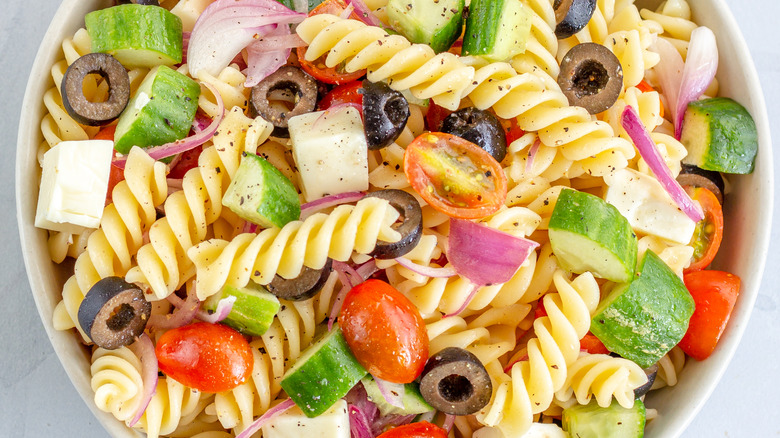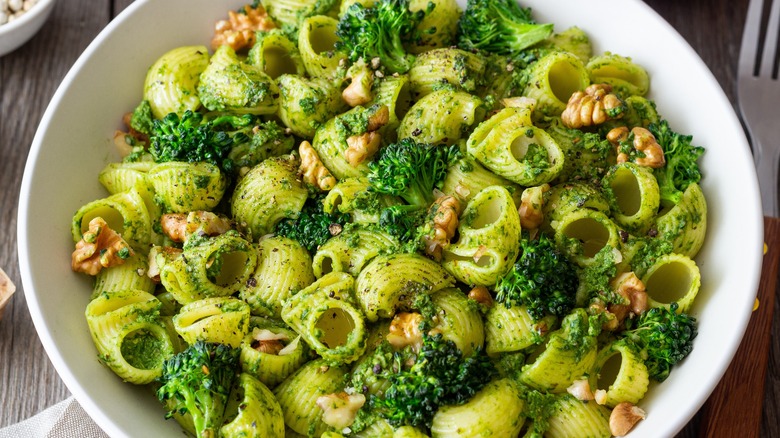Ina Garten's Unique Ratio For Perfect Pasta Salad
A basic pasta salad really doesn't ask for much: All you need is some cooked pasta, a few tablespoons of dressing, your choice of cheese, and just about any veggies that you can get your hands on. But why settle for mediocre pasta salads when Ina Garten has one simple tip to take them to the next level?
Garten is a master at elevating easy everyday meals with clever tricks, and her tomato feta pasta salad is the perfect example of this. Where most recipes go pretty heavy on the pasta and call for at least a pound or so of the star ingredient, The Barefoot Contessa does things a little differently: She reduces the amount of pasta and ups the ratio of other ingredients. The recipe cuts the fusilli in half and uses twice the amount of both feta and ripe tomatoes instead (via Food Network). She then adds more veggies in the form of sun-dried tomatoes and black olives.
While this particular ratio seems specific to the tomato feta recipe, the key here is to strike a balance between the starch, cheese, and veggies rather than throw them in as afterthoughts — a tip that can be applied to any salad of this kind. Take, for instance, Garten's own summer garden pasta: Even though it calls for a pound of dried angel hair noodles, it uses four whole pints of cherry tomatoes and 18 basil leaves to balance everything (via Barefoot Contessa).
The Barefoot Constesa's advice for great pasta salad
Ina Garten has many pro tips to make simple ingredients shine, and when it comes to pasta salads, her advice is to not let the pasta overshadow the other elements of the salad. When in doubt, however, you can always go by the ratio of 1-2-3-4. It's not a Garten technique, but it's useful — use 1 cup of a hearty ingredient (pasta, cheese, proteins, grains, and the like), 2 tablespoons of a crunchy topping (think pine nuts, sunflower seeds, pecans, or toasted walnuts), three types of vegetables or fruits (yes, summer fruits do belong in pasta salads), and 4 cups of leafy greens.
One thing to keep in mind when choosing your fruits and veggies is to select those with different flavors and textures. This is what will elevate the salad. Even Garten's tomato feta pasta salad calls for two kinds of tomatoes: fresh, bursting ripe ones and chewy sun-dried options for a rich contrast.
The Barefoot Contessa also finds that most pasta salads are bland and boring because they aren't seasoned properly. Grains and starches like pasta soak up liquids much better while they are still warm, which is why you should dress them early on for maximum flavor. You can still enjoy eating the salad when it's cold, but it's best to dress it in advance while the pasta still has some heat.
Upgrade your pasta salad with these tips
Ratios aside, there are several other factors that can differentiate a standard pasta salad from a truly great one. For one, the shape of your pasta can make all the difference. Short pasta such as orecchiette, fusilli, or elbow shapes work much better in salads than long noodles, which often get tangled when they cool. This is why it's also best to steer clear of stuffed pasta — they aren't ideal for cold preparations.
Next, choose your dressing wisely. Pasta is meant to be sauced, so those light summery vinaigrettes may leave much to be desired. Plus, acids don't pair well with pasta and can leave a sharp and metallic aftertaste. Ditch the vinegar for oil-forward options — think pesto, for example. You'll want to be more generous with the seasoning of the dressing as well because cold salads have a knack for being a touch bland.
Pasta salads also dry out as they cool in the refrigerator, so it's worth adding ingredients such as giardiniera or olives to bring a burst of juiciness to each bite. Although pasta salad is generally eaten straight out of the refrigerator, consider eating it at room temperature for better texture. You could even moisten it with another round of dressing right before you dig into it to jazz things up.



